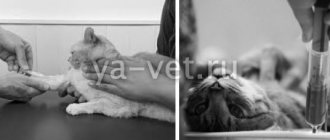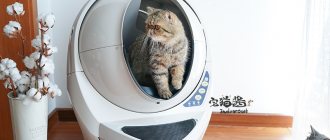In diagnostics and assessment of the general condition of an animal’s body, urine is one of the main providers of information. Its analysis allows us to determine the presence of foci of inflammation, infection, malfunctions of organs and systems. The accuracy of the results largely depends on the correct collection of urine. Errors and violations in this process can lead to incorrect diagnosis and ineffective treatment. Usually tests are taken by specialists at a veterinary hospital. But situations cannot be ruled out when the owners have to carry out this procedure. You should know how to carry out sampling correctly in order to get an accurate result during the study.
Reasons for taking a urine test
A urine test is necessary if the cat has symptoms indicating the presence of pathologies in the bladder or urinary tract. These include:
- frequent but fruitless trips to the litter box;
- changes in the color of urine, the appearance of blood and pus in it;
- painful emptying of the bladder, accompanied by loud meowing;
- the appearance of a strong odor in urine;
- ignoring the tray.
If your cat often goes to the litter box, but there are no results, it may be developing kidney failure or a blocked urinary tract. In this case, urgent assistance from a veterinarian is required. The normal color of cat urine is light yellow, but if it darkens, there is a disorder in the urinary system. The appearance of bloody spots may be a consequence of damage to the canal by an emerging stone. Pus in the urine appears during infectious processes.
When the urethra or kidneys become inflamed, pain appears during emptying of the bladder, causing the cat to meow loudly. In healthy animals, urine does not have a strong odor. Its appearance indicates the proliferation of bacteria in the genitourinary organs. Ignoring the tray is not always the cat’s revenge, his desire to mark his territory. This may be incontinence caused by a disease.
How to collect a urine test from a cat
Urinalysis in cats is one of the most important types of diagnostics for many diseases. Changes in urine tests for many diseases can be seen much earlier than changes in blood tests. Urine examination allows you to determine in the early stages of diseases of the kidneys and bladder, urinary tract, urolithiasis, chronic renal failure (which is very important, since chronic renal failure is the most common disease of old cats), diabetes mellitus and even help in diagnosing diseases of the liver and biliary tract .
Collecting a urine test from a cat is quite simple if you have one cat and only a little more difficult if there are two or more cats.
In most cases, a urine test cannot make a definitive and indisputable diagnosis. It serves to evaluate the composition of urine and understand where to move next. To make a final diagnosis, additional diagnostic methods are used and, importantly, the doctor must examine the animal and collect an anamnesis. For example, it is impossible to diagnose “urolithiasis” only on the basis of a urine test; it is also necessary to conduct an ultrasound of the kidneys and bladder. The presence of “sand” in a urine test does not prove that the animal has urolithiasis. Maybe the urine just sat for a long time before the analysis was done. Just like the absence of “sand” does not prove that there is no ICD. It happens that the urine is clear, but in the bladder during ultrasound diagnostics we see such oxalate, 3 cm in diameter. It lies there and does not crumble, but interferes with the animal’s life.
The ideal portion for urine analysis is in the morning. If it presses you, you can take any, but if time is of the essence, then it is better to collect it in the morning. For a correct analysis, urine is needed, which accumulates in the bladder for a long time.
A urine test won't last long. A reliable result can be obtained if the analysis is ready an hour or two after collection. If more time passes from the moment of collection to the analysis, then its reliability tends to zero. If you don’t have much time, work is on fire, or the laboratory is closed for lunch, there is a solution: buy/ask a test tube with a preservative at the clinic or laboratory. These are also sold in a regular “human” pharmacy. This tube will keep your urine suitable for analysis for about a day. We collected the urine in a test tube, closed the lid, turned it over a couple of times carefully so that the valuable liquid mixed with the preservative, and put it in a dark, cool place (you can’t freeze urine). And at a convenient time within 24 hours we were taken to the laboratory.
Something that is known to many, but not everyone uses it. There are special containers for urine analysis. Even those without preservatives are also special. Clean. Without foreign impurities. They are issued at any clinic, sold at any pharmacy, and cost pennies. And they are even sold at Auchan. Transparent, plastic, with a red lid, individually packaged.
Using urine analysis collected from a tray / from the floor / from an oilcloth, in general, “naturally” it is impossible to reliably judge the microflora living in the urinary tract. To donate urine to the tank. culture and get the correct result, you need to go to the doctor who will perform a procedure called “cystocentesis” - this is a puncture of the bladder through the abdominal wall. Absolutely not a scary and safe procedure.
A large number of red blood cells in the urine makes diagnosis difficult, so if the urine is mixed with blood, the doctor may prescribe another clarifying test after the urine acquires a color close to normal. And urine with a very large amount of blood may simply not be taken for analysis. This is normal; in such cases, other diagnostic methods are used, and the analysis is taken a little later, when it will be more reliable.
Traces of household chemicals and cleaning products change the important characteristics of urine! Also, when collected in unsuitable containers, urine may become contaminated. That is, before collecting urine, wash the tray only with water and scald it with boiling water, and jars of horseradish and cucumbers, even washed 10 times with “fairy”, are not suitable for storing urine.
The ideal amount of urine for analysis is 5-10, or better yet 20 ml; if you manage to collect that much, don’t be shy and leak a little - bring it all!
Now about how to collect a urine test from our mustachioed conspirators. Many cats are against donating their urine and won’t give up without a fight. They will ignore an empty tray or a tray with “not their” filler, hide and endure until the last minute if someone is spying on them, they may even find a secluded corner and do all their “business” there, quietly and unnoticed, if the owner is very persistent. So, the options:
Empty tray. The simplest and “cleanest” way. The tray must first be washed, scalded with boiling water and waited in ambush for the cat to go there. If there are several cats, then from time to time you will have to look at who is in the litter box; if it’s the same cat, run to get an analysis; if it’s the wrong cat, wash it and scald it again.
Cocktail straw. Circle “crazy hands”: take a pack of straws, cut them into many small cylinders with scissors, and after 10 minutes you have a decent pile of special filler. You can deceive a cat with it. This is how I deceive mine. In my opinion, he likes to pee in the tubes even more than in the litter.
Special filler for collecting urine. Can be purchased at a pet store, clinic or veterinarian. laboratories. It is poured like regular litter into a washed and scalded tray, the cat pees and the urine is collected with a syringe without a needle into a special container. The urine collection filler differs from the usual one in that it does not contain foreign impurities and does not absorb urine.
Bag or cling film. For cats who are not particularly fond of digging before the process. The film is placed on a regular litter, several holes are made, and after urinating the cat is not allowed to bury the film, the indignant mustache is pulled out of the tray, and the urine is collected from the depressions and from the film with a syringe. And pour it into a container. It is advisable that the film package does not rustle, this can scare the cat away from the tray for a long time.
An unlikely option, but some people succeeded. While the cat is peeing, go behind him and slide a plastic plate or small saucer under the cat . The cat can calmly finish his business, or he can become very indignant and offended.
If the cat pees in the sink or bathtub. You need to thoroughly clean the sink/tub without using household chemicals and scald with boiling water. Take a bag or cling film and place it in the drain so that a depression is formed. When your cat pees, you can collect the urine from the cavity into a container.
If the cat goes to the toilet . We take cling film and attach it to the edges of the toilet, making a recess in the center. You need to attach it in such a way that the film does not collapse under the weight of a portion of urine, and the cat does not see it, that is, you get a rather deep “hammock.”
In extreme cases, urine can be collected in the clinic using catheterization or bladder puncture . It does not hurt! But all the same, if the test is taken for prevention and there are no special requirements (for example, if it is not a bacterial culture), then it is still better to collect urine at home.
For cats older than 7-8 years, especially those with a history of urinary system diseases, it is recommended to test urine once every six months. Take care of your mustaches!
Author: Ksan
Analysis methods
There are several ways to collect urine from cats. Not all of them can be used at home. You can collect analysis:
- cystocentesis;
- catheterization;
- urine collector;
- from the tray, toilet.
Cystocentesis for urine collection is used by specialists in veterinary hospitals. During the procedure, the abdominal wall and bladder are pierced with a needle. Catheterization is also performed by a veterinarian. This technique is used when independent urination is impossible. A catheter is inserted into the pet's bladder, and urine comes out through a tube.
At home, you can use a urine bag designed for babies. You can collect urine from the tray if it has been well cleaned and disinfected before. Some owners train cats to relieve themselves in the toilet. To collect the analysis, you should block the drain and put a polyethylene film. After urination, pour the urine into a container.
Selection methods at home
Tray fence
A simple method is suitable if the cat is accustomed to going to the basin. First you need to wash with a powerful stream of water, and then with boiling water from a kettle. The use of gels, shampoos, alkaline, acidic detergents and laundry soap is prohibited, because this will affect the urine. The surface must be thoroughly wiped. Filling cannot be done as it will affect the discharge. Once your cat has emptied its bladder, you need to collect the urine in a plastic container. According to the observations of felinologists, a pet accustomed to artificial filler in a basin may not want to defecate in an empty one. In this case, you can use the following methods:
The best option for the owner is to purchase a special filler.
- Making a scoop. You can cut a plastic scoop from a disposable bottle and place it under the cat when he begins to empty his bladder. However, this method can frighten your pet and cause further problems with going to the toilet. Veterinarians prohibit lifting or moving a cat during urination.
- Cellophane film. As an alternative, clear packaging material can be placed over the scoop. Urine should be collected with a syringe. The needle can be removed for convenience.
- Special filler from a store kit for collecting urine. The safest and most stress-free way for your pet is to pour plastic balls, which can be purchased at a pet store, into the tray. The material does not absorb urine and does not affect its characteristics. The set includes a pipette that can be used to take the cat's natural secretions. The filler should then be rinsed and used again if necessary.
Urine from the bath
If the cat is accustomed to go to the bathroom when needed, then urine collection can be carried out according to the following algorithm:
If your pet defecates in the sink, you can place a clean bag in the sink drain.
- Clean the bathtub, washbasin or toilet with a brush or damp cloth. Cleaning agents cannot be used, but sodium carbonate can be applied.
- The inner surface is doused with boiling water. It is important to remove any remaining baking soda if it was used to remove streaks and old dirt.
- Cellophane is placed in the drain area so that a hole is formed.
- To collect urine you need a disposable syringe.
Children's or cat's urine collector
If collection at home is not possible, you can contact your veterinarian to take urine directly from the bladder or perform catheterization.
If it is impossible to force the cat to go into an empty tray or bathtub, you can buy a children's urine collection tank at a pharmacy or a urine bag at a pet store. The difficulty of the method is due to the fact that pets react aggressively to the accessory and can tear it or steal it. Veterinarians recommend buying 2-3 devices at once. Before placing the urine collection bag, you need to disinfect and wash your hands, and then carefully remove the Velcro from the bag. The device is glued to the cat under the bladder so that the anus is not affected. When a pet goes to the toilet, it is important to remove the urine bag carefully, without scaring the cat or causing discomfort.
Features of cystocentesis
The main advantage of cystocentesis is the guarantee of sterility and accuracy of the analytical results obtained. It is highly undesirable to carry out such a procedure without medical skills. If you have such experience, you can collect urine from your cat at home. During the procedure, the pet can:
- stand;
- lie on your back;
- lie on your side.
Every effort should be made to calm the cat and she should remain motionless until the needle is removed. If you choose the right position and injection site, the animal will not feel pain.
Calming your pet is important not only to prevent sudden movements. In a relaxed body, the bladder is easier to palpate. Further actions are as follows:
- feel the bubble, fix it;
- gently move the organ towards you;
- smoothly and slowly insert the needle into the skin;
- continue insertion until the cannula comes into contact with the body;
- carry out the sampling, relax the bubble, carefully remove the needle.
Usually there are no negative consequences after this procedure. A hematoma may form at the site where the needle was inserted; it will gradually resolve on its own. If the vagus nerve is irritated during sampling, shortness of breath, gagging, and hiccups may occur. There is a risk of bladder rupture if there is urethral obstruction. Veterinarians, when detecting this pathology, choose a different method of collecting urine.
Collecting urine if the cat goes to the bath
Sometimes a cat is trained to go to the toilet not in the litter box, but in the bathroom or sink. In such a situation, collecting urine is quite simple, despite the fact that at first glance it may seem like a very difficult task. First, the sink or bathtub is thoroughly cleaned. Detergents cannot be used. Then cover the inside with several layers of cling film so that there is a depression at the drainage site.
© shutterstock
After the cat has urinated, the urine is collected in a syringe without a needle. It is then poured into a container for transportation. The dirty film is removed. We can say that when urine is collected in this way, the animal feels most comfortable, but only if the cat is accustomed to going to the toilet in this way.
Specifics of catheterization
Catheterization is performed only in extreme cases. This method has a high risk of infection in the urinary system. But such a procedure is necessary for urolithiasis, the presence of malignant tumors, and urethral obstruction. Before installing the catheter, a massage is performed to reduce and move sand plugs. In some cases, after this procedure, the ability to urinate is restored.
Anesthesia is not always used during catheterization; the animal has the opportunity to survive the procedure without pain relief. It additionally uses drugs that dissolve stones and sand plugs. The catheter is installed by a veterinarian, after which the medications necessary to eliminate the risk of infections and eliminate painful symptoms are prescribed. Usually prescribed:
- antispasmodics;
- anti-inflammatory drugs;
- antibacterial drugs.
The doctor may also prescribe anesthetics.
Urine sample requirements
Of course, the first morning urine is the most informative. And if with a dog this problem is easily solved, then cats walk on their own, at night they have the right not to sleep, but to go about their cat business, and which urination of the pet will be the first is a complex question. Therefore, with cats this rule can be neglected.
As with people, it is better to take a medium portion of urine from animals, but cats use a litter tray, in small breeds of dogs the volume of urination is not so large that it is worth dividing, and males generally urinate in portions. Therefore, here – what you collect is good.
The purity of the sample is something that should be fought for, because a dirty sample is more likely to give an incorrect result. Do not collect urine from the floor or pour it into contaminated containers.
The sample storage period must be observed, otherwise the result, again, will be distorted. Urine can be stored at room temperature for no more than an hour. If you cannot deliver it to the laboratory within this time frame, immediately put the sample in the refrigerator.
Using a urine bag
You can take an analysis using a urine collection bag. If there is no special device for animals, you can purchase a device intended for infants at the pharmacy. The edges of the container into which urine will be collected are treated with an adhesive compound. It needs to be fixed in the genital area. Most likely, the pet will be dissatisfied with the presence of a foreign object on the body and will make every effort to remove it. You need to wear a diaper that will block access to the urine collection bag.
This urine collection device should be used as follows:
- wash and disinfect hands;
- remove the container from the packaging;
- remove the protective tape;
- secure the container in the genital area;
- put on a diaper.
When the container is full, the urine collector is carefully removed, and the urine is poured into a container that must be prepared in advance.
Special kit for urine collection
When a cat cannot go to the toilet without litter, and the owner is unable to place clean dishes under the pet, it is necessary to purchase a special kit for collecting material for analysis. It turns out to be an indispensable help in such a situation. The set includes a special filler made of plastic granules, which do not absorb urine and do not change its composition. The kit also includes a special pipette for collecting urine.
A special filler is poured into a clean tray, on which the pet will urinate. Once the urine is collected, the granules do not need to be thrown away. It is enough to rinse them thoroughly and put them in a bag for storage . If urine needs to be collected again, the same filler can be used. Using a special kit, you can easily collect your cat’s urine for analysis. This method is the simplest and most reliable.
Method one, don’t ignore it
If you are faced with the question of how to collect urine for analysis from a cat for the first time, and you have enough free time, then you can try to simply watch for your pet while going to the litter box. You will have to use a similar method if the cat is accustomed to going into a container with filler. You just need to prepare a clean cup and place it under the cat when he sits on the tray. This is not so easy to do, but it is quite possible.
Urine collector for children
It can only be used for hairless cat breeds, or you can pre-cut some of the fur. For pets with thick fur, it simply won’t hold up. Moreover, you will have to buy not one, but several devices at once, since it is rarely possible to collect material for analysis the first time. The algorithm is approximately the following:
- Wash your hands using laundry soap.
- Open the urine collection bag, which is a sterile soft 100 ml bag.
- Remove the protective layer.
- Place the urine bag in the area between the anus and genitals.
As soon as the cat empties its bladder, you must immediately remove the urine collection bag, pour it into a clean container and send it for analysis.
Why should a cat get tested?
When an animal gets sick, the help of a veterinarian is required. Identifying the cause of the disease begins with an external examination. However, this method is not always informative, so doctors take biological fluids.
Analysis is a set of methods for determining the cause of a disease by studying biological material (urine, blood, feces, sputum). Tasks:
- determining the cause of the disease;
- establishing the stage of the disease;
- prescribing the correct treatment.
Laboratory tests are carried out for diagnosis, as well as for prevention purposes. Taking tests is a stressful procedure for an animal. In order not to irritate a pet who is weakened due to illness, it is advised to call a veterinarian at home.
1. Blood test for a cat. Before adoption, the pet’s diet and physical activity are limited. The cat should not run, jump, or play much before the procedure. The accuracy of the result will increase if you take blood on an empty stomach.
2. Stool examination. The main restrictions affect nutrition. You cannot give meat, fish products, grass and greens before delivery.
3. Urinalysis. Giving diuretics is prohibited. It is not recommended to feed foods that change the color of urine. Advice for owners is to wash the pet’s belly and genitals before collecting.
Following the recommendations presented allows you to find out accurate results. It is recommended to carry out all preparation procedures before the veterinarian arrives at your home.
The study of biological fluids helps doctors identify viral, bacterial, fungal infections, helminthiasis, inflammatory processes, and skin pathologies. To check the health of cats, blood, urine, feces, scrapings and swabs are often taken from cats.
Using a tray
If the container is without filler, it will do just fine. A cat litter box with a grid is one of the most convenient options, provided it is used correctly. The first step is to wash it thoroughly to prevent bacteria that live on its walls from getting into the urine. To do this, use laundry soap, hydrogen peroxide or chlorhexidine.
There is another method that can be successfully used. You also need to keep an eye on your pet. As soon as the cat sits down and begins to urinate, they immediately grab him by the scruff of the neck, lift him up, and fill the bowl with urine. I must say that the method is far from the best. It poses a risk of negative side effects, the main of which are the following:
- Difficulty urinating due to severe stress. Such conditions do not always pass without leaving a trace.
- The cat may stop going to the litter box out of fear of being grabbed again. In this case, puddles will appear throughout the house.
- The unexpected may cause bladder spasm. Here it is important to take into account the character of your pet, how timid he is.
We suggest you read: Why does a cat carry kittens in her teeth?
By the way, today there are a lot of models of trays. Breeders praise the toilet - a house for the cat, where he feels very comfortable. These models are the most convenient for placing a bowl to collect urine without your pet noticing anything.
Interpretation of results
What does a cat's urine test show? First of all, the doctor evaluates physical characteristics such as color, transparency and density. Brown color indicates liver problems, and reddish color indicates kidney disease. As far as transparency is concerned, only slight haze is acceptable. If it becomes pronounced, this indicates the presence of leukocytes, red blood cells and bacteria in the urine. In this case, it is recommended to conduct additional examination, namely microscopic and chemical examination of the sediment.
Microscopic examination
A well-conducted microscopic examination can reveal even diseases of the kidneys and excretory tract that are externally asymptomatic. At the microscopic level, urine sediment is examined and the content of the following substances in it is determined:
- epithelium (usually not present, a small amount of squamous epithelium is acceptable);
- leukocytes (normally from 0 to 3);
- red blood cells (in a healthy animal 0-5 units);
- cylinders (in the normal state there are no more than a couple of healine cylinders in the sediment);
- mucus (its presence in small quantities is not a sign of pathology);
- crystals (may be present in small quantities in a healthy cat);
- bacteria (the urine of a healthy animal is sterile and does not contain bacteria).
Procedure for massage
Before starting the procedure, you need to calm your pet with gentle words or stroking the head.
At the same time, you need to carefully palpate the abdomen to assess the degree of bladder density
Next you need:
Place the cat on its back or side, but the procedure can also be carried out in a standing position. Check that there are no tiny stones on the penis that could interfere with the passage of urine
If the latter are detected, they must be removed: run your fingers, lubricated with a special gel or soap, from the edge to the base of the genital organ, gently squeezing it. Cup your hand and gently massage the bladder, making clockwise circular movements to direct the flow of urine towards the external genitalia. You can also try light pressure on both sides of the bladder with two palms.
Important! In no case should you make strong pressing movements, since any carelessness can lead to rupture of the bladder. The main thing in the massage process is not strength, but the correctness of movements.
After some time, a small amount of urine will begin to be released, although a small amount of blood will be acceptable. With urolithiasis, accumulations of sand and salts will come out of the body in the form of a white paste.
If the pet breaks out and scratches, you can ask an assistant to hold the cat by the paws and soothe it by stroking the neck. If all manipulations are done correctly, the animal will be able to urinate in the tray
It is important that the bladder is at least 50% empty. If the cat does not resist too much during the massage, you can continue the procedure until it is completely emptied.
For the first time, your pet will probably disapprove of the massage procedure and pressure on the stomach
But it is important to understand that the health and life expectancy of the cat depends on how fully and correctly the procedure is performed, since prolonged urine retention in the body causes poisoning of the animal











